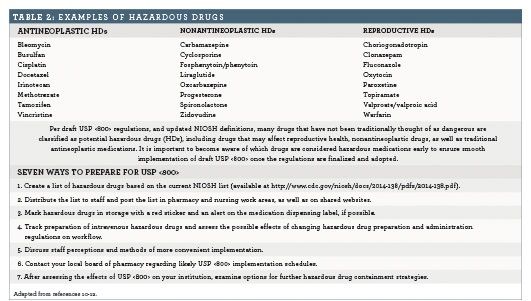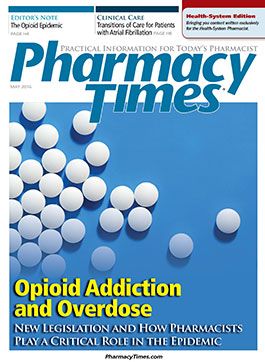Publication
Article
Pharmacy Practice in Focus: Health Systems
Closed-System Transfer Devices: Design Characteristics and Evolving Performance Standards
Author(s):
Closed-system transfer devices are systems used to transfer medication from 1 reservoir to another while limiting the potential for drug aerosolization, drug contamination, sharps exposure, and hazardous drug exposure.
Closed-system transfer devices (CSTDs) are systems used to transfer medication from 1 reservoir to another while limiting the potential for drug aerosolization, drug contamination, sharps exposure, and hazardous drug exposure.1 In August 2015, the National Institute for Occupational Safety and Health (NIOSH) published a draft performance protocol for testing CSTDs for their ability to effectively contain medication during the preparation, compounding, or administration process.2
Once connected to the reservoir (typically a drug vial) CSTD devices equalize the pressure gradient between the vessel containing the drug and the syringe. Without a pressure equalization system, differences in pressure can lead to the generation of fine aerosols that may escape into the air and expose the environment, patients, and health care professionals to hazardous drugs. Other CSTDs use an integrated filter to cleanse escaping air contaminated with hazardous drug vapors or aerosols.1,2
THE RELEVANCE OF CSTDS
Limiting exposure to hazardous drugs is important due to the potential for harm to pregnant women and due to the increased risk of chromosomal abnormalities associated with hazardous drug exposure in all health care workers. Both of these risks are welldocumented in health care workers preparing, handling, and administering hazardous drugs on a regular basis.3,4
In a 1999 study, Valanis and colleagues compared pregnancy outcomes from nearly 3000 nurses, pharmacists, and pharmacy technicians, and also compared pregnancy outcomes among these health professionals with outcomes from more than 4000 women who were not health care workers.
In the final analysis, researchers identified an increased risk of harm in health care professionals versus women who worked in other industries. The risk of spontaneous abortion or stillbirth was 40% higher in women handling hazardous drugs during pregnancy, which was statistically significant based on a confidence interval that did not cross unity (OR 1.4; 95% CI, 1.2-1.9).3
In a more recent study published in 2010, McDairmid and colleagues identified significantly higher rates of chromosome 5 and 7 abnormalities among health care workers handling antineoplastic medications. In the study, blood samples were collected from 109 health care workers to compare the frequency of hazardous drug handling with the presence of chromosomal abnormalities.

In a high-exposure group versus a low-exposure group, study authors found significantly higher rates of structural chromosomal abnormalities (0.18/person vs 0.02/person; P = .04), a 24% greater risk of chromosome 5 abnormalities (P = .01), and a 20% greater risk of chromosome 5 or 7 abnormalities (P = .01). These results confirm that exposure to hazardous drugs is associated with possible DNA damage, which may lead to serious consequences over time, including cancer.4
To reduce this risk, researchers have conducted studies to show the benefits of CSTD systems, both in reducing worksite contamination with hazardous drug residues and in reducing realworld exposure. For instance:
- More than 25 published studies support the performance and efficacy of the BD PhaSeal System in protecting health care workers from hazardous drugs (see bd.com/ pharmacy/phaseal/evidence/ studies.asp).
- Sessink et al (2011) reported levels of surface contamination of antineoplastic drugs in 22 US hospitals before and several months after adoption of the BD PhaSeal CSTD system. Levels of surface contamination with all 3 antineoplastic drugs sampled were significantly lower: cyclophosphamide (95% reduction; P <.0001), ifosfamide (90% reduction; P <.001), and 5-fluorouracil (65% reduction; P <.01).5
- Wick and colleagues (2003) determined that the BD PhaSeal system led to real-world reductions in personnel exposure. Before and 6 months after implementation of the BD PhaSeal CSTD in a hospital pharmacy, all personnel were evaluated using 24-hour urine samples. Of 8 employees, 6 showed evidence of exposure to cyclophosphamide and 2 showed evidence of ifosfamide exposure prior to the use of the BD PhaSeal System. After implementation, none of the 8 employees had evidence of cyclophosphamide or ifosfamide in their urine samples.6
- Clark and colleagues reported the efficacy of the EquaShield CSTD in reducing surface contamination at a single cancer center before and after the system’s adoption. Researchers used a kit to collect samples from 5 areas of the pharmacy, 5 areas of the infusion suite, and 2 areas in offices. Whereas approximately half of the samples showed contamination before adoption of the system, no contamination with cyclophosphamide or 5-fluorouracil was identified in the final sample collection (for other evidence, see equashield.com).7
​CSTD DESIGN CHARACTERISTICS
CSTDs fall into 2 categories: those that develop systems that are closed and those that use air-cleaning technology to limit the flow of contaminants from within a vial to the environment (air-cleansing systems). Typically, systems of the second type incorporate an activated carbon filter or hydrophobic filter to help reduce the outflow of contaminants. Furthermore, CSTDs are supplemental engineering controls that are intended for use with other safety systems, such as biological safety cabinets and containment isolators.2
EARLY METHODS OF CSTD ASSESSMENT
Several methods have been used to assess the efficacy of CSTDs in containing hazardous drugs. Some of the more technical methods employed smoke, titanium vapor, lactose, fluorescein, and sulfur hexafluoride, whereas simpler methods for an informal assessment of efficacy used ordinary coffee and lemon juice. The latter 2 tests can be performed in a pharmacy setting as a demonstration.8,9

Testing a CSTD with coffee involves drawing coffee from a sealed container into another. Any smell of coffee may indicate leakage. In another example, lemon juice may be drawn into a CSTD. Holding litmus paper near the connector or in the area around the carbon filter vent or the vial/CSTD junction indicates whether or not the highly acidic lemon juice is escaping. Any change in color of the litmus paper indicates potential leakage.8,9
Until recently, there has been no established protocol for testing CSTDs in a standardized way. This has recently changed with publication of a draft vapor containment by NIOSH, which enables direct testing of different CSTDs under identical conditions for comparison of protective efficacy.2,8,9
NIOSH CONTAINMENT PROTOCOL
NIOSH developed this draft protocol to demonstrate which CSTDs are truly effective in preventing drug vapors or liquids from escaping into the environment. This draft performance protocol enables unbiased comparison of CSTDs and provides some basis for choosing a product based on its comparative efficacy with other systems. However, according to NIOSH, this protocol is not applicable to CSTDs that use an air-cleansing system—only products that are closed from the outside environment can be evaluated.2,8,9
In the past, several attempts to assess CSTDs have included use of the inorganic tracer gas sulfur hexafluoride, lactose powder, and fluorescent compounds. However, for this protocol, NIOSH settled upon 70% isopropyl alcohol (IPA) as a tracer compound due to its propensity to generate vapor at room temperature, its ubiquity, and the availability of equipment to reliably measure concentrations of IPA within a test environment using a gas analyzer (the Miran SapphIRe detector, which reports IPA concentrations in parts per million once per second).2
Per the NIOSH protocol, the detector continuously measures IPA concentrations in a sealed environmental test chamber (Secador Techni-dome 360 Large Vacuum Desiccator) where CSTD manipulations occur. Furthermore, the CSTD test protocol specifies testing for several types of connections made with CSTDs, including connection of the CSTD with several types of adaptors. These may include adaptors that connect with vials, ports, Y-sites, and intravenous bags.2
IPA detectors have an important limitation: they cannot establish that zero IPA has escaped from a CSTD. However, they can establish that IPA is not present at concentrations above a lower limit of detection, below which the detector cannot reliably establish IPA levels. For the Miran SapphIRe detector, this limit of quantification is 1 part per million—an astonishingly low concentration, equivalent to 1 teaspoon of water in a 5000-liter tank. According to NIOSH, this setup offers assurance that, “CSTD performance was as good as could possibly be measured using the particular instrument within the evaluation protocol.”2
RELEVANCE FOR PHARMACISTS
Testing standards for CSTDs have not been standardized by the FDA. Although the FDA established a CSTD product code, called an ONB code, that is obtainable by CSTD manufacturers through submission of additional protective efficacy data, the tests used were not standardized. Establishment of the draft NIOSH protocol for CSTD testing may enable the FDA to confirm the efficacy of certain CSTD systems with a higher level of evidence. With this evidence, pharmacists and nurses can be assured that CSTDs are offering the best protection possible against hazardous drug contamination.8,9
Importantly, the draft NIOSH protocol will not evaluate the effectiveness of filtered or air-cleansing systems. Recognizing the difference between systems that are closed and air-cleansing is an important priority in making a wise selection in CSTD effectiveness. Further, pending the results of testing with the draft NIOSH protocol, differences between systems that are closed may be apparent.8,9-12
Design characteristics of the system with the longest track record (PhaSeal, approved by the FDA in 1998) include a metal needle, a closed design, and a double-membrane connector. A different system with these 3 characteristics, Equashield/Equashield II, shares some important design characteristics in common. However, these 2 systems differ in important ways, and choosing an appropriate system may require discussion with company representatives.8-12
In choosing an appropriate system, it is important to take into account all available efficacy data and to make an informed choice, as not all CSTDs are equally effective in containing hazardous medications. Examining and comparing the design characteristics of different systems—including differentiation of closed from air-cleansing systems—is a key consideration in this choice.
Michael R. Page, PharmD, RPh
, earned his PharmD from the Ernest Mario School of Pharmacy at Rutgers University. He has worked as a community pharmacist at CVS Pharmacy and is currently clinical editor in clinical and scientific affairs at Pharmacy Times.
References
- NIOSH. Preventing Occupational Exposures to Antineoplastic Drugs. http://www.cdc.gov/niosh/docs/2004-165/pdfs/2004-165.pdf. Accessed November 2015.
- NIOSH. A Vapor Containment Performance Protocol for Closed System Transfer Devices Used During Pharmacy Compounding and Administration of Hazardous Drugs. http://www.cdc.gov/niosh/docket/review/docket288/pdfs/a-vapor-containment-performance-protocol-for-closed-system-transfer-devices.pdf. Accessed November 2015.
- Valanis B, Vollmer WM, Steele P. Occupational exposure to antineoplastic agents: self-reported miscarriages and stillbirths among nurses and pharmacists. J Occup Environ Med. 1999;41(8):632-638.
- McDiarmid MA, Oliver MS, Roth TS, Rogers B, Escalante C. Chromosome 5 and 7 abnormalities in oncology personnel handling anticancer drugs. J Occup Environ Med. 2010;52(10):1028-1034.
- Sessink PJ, Connor TH, Jorgenson JA, Tyler TG. Reduction in surface contamination with antineoplastic drugs in 22 hospital pharmacies in the US following implementation of a closed-system drug transfer device. J Oncol Pharm Pract. 2011;17(1):39-48.
- Wick C, Slawson MH, Jorgenson JA, Tyler LS. Using a closed-system protective device to reduce personnel exposure to antineoplastic agents. Am J Health Syst Pharm. 2003;60(22):2314-2120.
- Clark BA, Sessink PJ. Use of a closed system drug-transfer device eliminates surface contamination with antineoplastic agents. J Oncol Pharm Pract. 2013;19(2):99-104.
- Massoomi F. Assessing Vial Transfer Devices for Handling Hazardous Drugs. http://www.pppmag.com/article_print.php?articleid=515. Accessed November 2015.
- Power LA. Assessing Vial Transfer Devices for Handling Hazardous Drugs. PPN. 2013.
- Page MR. USP <800>: New Regulations to Protect Health Care Workers from Hazardous Drugs. http://www.specialtypharmacytimes.com/publications/specialty-pharmacy-times/2015/april-2015/usp-800-new-regulations-to-protect-health-care-workers-from-hazardous-drugs. Accessed November 2015.
- Page MR. Protecting Health Care Workers: Handling Hazardous Drugs. http://www.pharmacytimes.com/publications/health-system-edition/2015/september2015/protecting-health-care-workers-handling-hazardous-drugs/. Accessed November 2015.
- Page MR. Selection of Closed-System Transfer Devices: Tips for Engaging Nursing and Pharmacy Stakeholders in Purchasing Decisions. http://www.specialtypharmacytimes.com/publications/specialty-pharmacy-times/2015/october-2015/selection-of-closed-system-transfer-devices-tips-for-engaging-nursing-and-pharmacy-stakeholders-in-purchasing-decisions. Accessed November 2015.







